Vea también


 04.04.2025 06:06 AM
04.04.2025 06:06 AMThe EUR/USD currency pair gained nearly 300 pips between Wednesday and Thursday. We saw a repeat of the situation in early March when the U.S. dollar fell by 400 pips in just three days—although the current decline is even more intense. However, the exact magnitude of the fall doesn't matter. What's important is that the market once again responded clearly to how it views Donald Trump's tariffs. And that response was obvious: no one wants the dollar, the U.S. stock market is falling, and even Bitcoin is declining.
The market had been prepared for Trump to implement broad tariffs in the 10–15% range. But in reality, he not only imposed a 10% tariff on imports from all countries worldwide, he also compiled a list of nations that he believes treat the U.S. "most unfairly" and introduced individual tariffs for them. It's worth noting that while most countries will face a 10% tariff, some could see rates as high as 100%. Analysts have estimated that the average tariff across all affected countries is around 29%. China alone has received three separate sanction packages.
In truth, no other details matter. Trump stated that all the "sanctioned" countries need to do is eliminate all taxes and tariffs on U.S. exports and call the White House. From this perspective, he may appear to be acting reasonably—imposing tariffs on those countries that tax American goods in return. But for traders, fairness is irrelevant. And so it is for us. The entire world doesn't care anymore.
The European Union is preparing retaliatory measures. China, South Korea, and Japan are considering forming a trade alliance. As we've said, the major players on the geopolitical map will respond, while weaker ones will try to negotiate with the combative Trump. This new trade system will result in losses for all participants in the global market, one way or another. But Trump is unconcerned. He aims to replenish the national treasury and bring back factories and manufacturing to the U.S. His stance is simple: if you don't want to pay tariffs, produce goods in America. This would create jobs and boost the economy.
In other words, the U.S. is ready for an economic contraction, which will occur regardless, as relocating requires time. But will such a relocation occur? And will it happen at the scale Trump is counting on? Another key point is that a massive number of people around the world are now ready to boycott American goods. Previously, such sentiment mainly came from Canada, the EU, and a few other countries. But now, a widespread social media campaign under the hashtag "Boycott American" and plenty of supporters are gaining serious momentum.
As of April 4, the average volatility of the EUR/USD pair over the past five trading days is 137 pips, which is considered "high." We expect the pair to move between the levels of 1.0901 and 1.1175 on Friday. The long-term regression channel is pointing upward, indicating a short-term uptrend. The CCI indicator entered overbought territory yesterday, suggesting a possible correction. However, the overall trend remains bullish.
S1 – 1.0986
S2 – 1.0864
S3 – 1.0742
R1 – 1.1108
R2 – 1.1230
R3 – 1.1353
The EUR/USD pair continues its upward movement, which has become a trend. For several months, we've consistently said that we expect only a medium-term decline in the euro, and that view hasn't changed. The dollar still has no fundamental reason to weaken—except for Donald Trump. But that single factor continues to drive the dollar into freefall. This is an unprecedented and rare case for the currency market. Short positions still look attractive, with targets at 1.0315 and 1.0254, but it's currently very difficult to say when the "Trump-driven" rally will end. If you're trading purely on technicals, long positions may be considered if the price remains above the moving average, with targets at 1.1175 and 1.1230.
Linear Regression Channels help determine the current trend. If both channels are aligned, it indicates a strong trend.
Moving Average Line (settings: 20,0, smoothed) defines the short-term trend and guides the trading direction.
Murray Levels act as target levels for movements and corrections.
Volatility Levels (red lines) represent the likely price range for the pair over the next 24 hours based on current volatility readings.
CCI Indicator: If it enters the oversold region (below -250) or overbought region (above +250), it signals an impending trend reversal in the opposite direction.
You have already liked this post today
*El análisis de mercado publicado aquí tiene la finalidad de incrementar su conocimiento, más no darle instrucciones para realizar una operación.
El par de divisas GBP/USD también se negoció el lunes con baja volatilidad y prácticamente en una dirección lateral, aunque la libra esterlina mantiene una ligera inclinación alcista. A pesar
El par de divisas GBP/USD el viernes también se negoció con baja volatilidad y sin ningún entusiasmo. Sin embargo, la libra esterlina todavía mantiene una ligera inclinación alcista
El par de divisas EUR/USD el jueves continuó negociándose de manera bastante tranquila, aunque la volatilidad sigue siendo bastante alta. El dólar estadounidense mostró esta semana al menos alguna recuperación
El par de divisas el par GBP/USD también se movió al alza el lunes, aunque no hubo razones claras ni fundamentos específicos para ello. Sin embargo, la libra esterlina
Gráfico Forex
versión web

Your IP address shows that you are currently located in the USA. If you are a resident of the United States, you are prohibited from using the services of InstaFintech Group including online trading, online transfers, deposit/withdrawal of funds, etc.
If you think you are seeing this message by mistake and your location is not the US, kindly proceed to the website. Otherwise, you must leave the website in order to comply with government restrictions.
Why does your IP address show your location as the USA?
Please confirm whether you are a US resident or not by clicking the relevant button below. If you choose the wrong option, being a US resident, you will not be able to open an account with InstaTrade anyway.
We are sorry for any inconvenience caused by this message.


